WORDPRESS
31 Best Minimalist WordPress Themes for Clean Design in 2023

Minimalist WordPress themes have been around since the very beginning of WordPress.
However, minimalist design continues to change with new technology and upcoming trends.
What was cool three years ago may not be so hip today.
That’s why we curated this up-to-date list of the best minimalist WordPress themes.
You’ll also discover important aspects to consider when making your decision.
Let’s dive in.
What to Look Out for in Minimalist WordPress Themes
There are certain key aspects you should look out for in a minimal WordPress theme.
Here are a few to consider to help you make the best choice.
Simplicity
Simplicity is a key aspect of minimal web design. Often only using necessary elements and avoiding clutter.
Some WordPress themes offer more simplicity than others, so be sure to check their demos when making your decision.
Typography
Another area that encapsulates minimalistic design in WordPress themes is typography.
Using the right font family is essential. Not only that, but other aspects such as font size and line height are important.
Most themes will allow you to customize the font to suit your needs. Bear this in mind when browsing your options.
Use of Color
Minimal design typically uses a limited color palette, with one or two accent colors used.
This draws the eye away from any one object and focuses your attention on the imagery and the content.
Use of White Space
White space is the quintessential feature of modern web design.
Also known as negative space, the use of white space creates a sense of openness and clarity.
Features to keep an eye out for are the ability to customize page margins and padding.
Functionality
Every WordPress site should focus on functionality, and minimal design even more so.
As long as it’s easy to navigate and design features are easy to interact with, you can feel more confident in this area.
Also, keep in mind the functionality of the admin area and methods used to customize the front end of each theme.
Attention to Detail
With minimal design, less is often more. Themes that consider the fine details are the ones to look out for.
Responsive Design
Responsive WordPress theme design is a standard practice in almost all themes these days.
What’s important is how each responsive element is placed when viewing from different devices.
If mobile design is important to you, make sure you view the demos from smaller devices before you buy.
31 Best Minimalist WordPress Themes for Clean and Professional Design
After researching over 100 minimalist WordPress themes, these were the best ones we found.
There are themes for bloggers, artists, photographers, eCommerce stores, and more.
1. Astra – Our Top Pick for a Multipurpose Theme with Minimalist Templates
Astra is at the top of our list because it has hundreds of starter templates to choose from, many of which are free and minimal in design.
For instance, the Planet Earth template has a spacious feel to it, using elegant fonts and visually appealing images.
The Life Coach template uses lots of negative space and draws your eyes to the content.

And the Freelance Copywriter template is very clean and uses a minimal color palette.

The best thing about any of the templates is that you can customize them however you like.
For example, if you like Freelance Copywriter, but you want to design it for an interior designer, it’s entirely possible.
That’s because Astra is a multipurpose theme compared to others on this list, which center around one design.
Other features worth mentioning:
- The total size of this theme is less than 50 KB, making it lightning fast and lightweight
- It’s easy to use and has extensive documentation
- It works with all the popular page builders
- Customization options are practically unlimited
If that’s not enough, Astra is one of the most popular WordPress themes, used on over 2 million websites. It also has 5,000+ five-star reviews.
The free templates are awesome, but you get so much more when you’re ready to upgrade to Astra Pro.
2. GeneratePress – Runner Up for Best Minimal WordPress Theme
The runner-up in this list is GeneratePress, simply due to its popularity and trust within the WordPress community.
With over 500,000 active installs and 4 million total downloads, you can’t go wrong with GeneratePress.
But, to get the most out of it, you’ll want to upgrade to the Pro version, which gives you a license for 500 websites and all the features.
There is also a lifetime offer, which means you pay once and get updates forever.
Upgrading unlocks all the pre-made templates, which include some stunning minimalistic layouts.
For example, Avery is a feminine-style blog template with an angelic feel and subtle colors:

Or if you want to start a pet blog or offer services for animals, the My Pet template is very clean and professional:
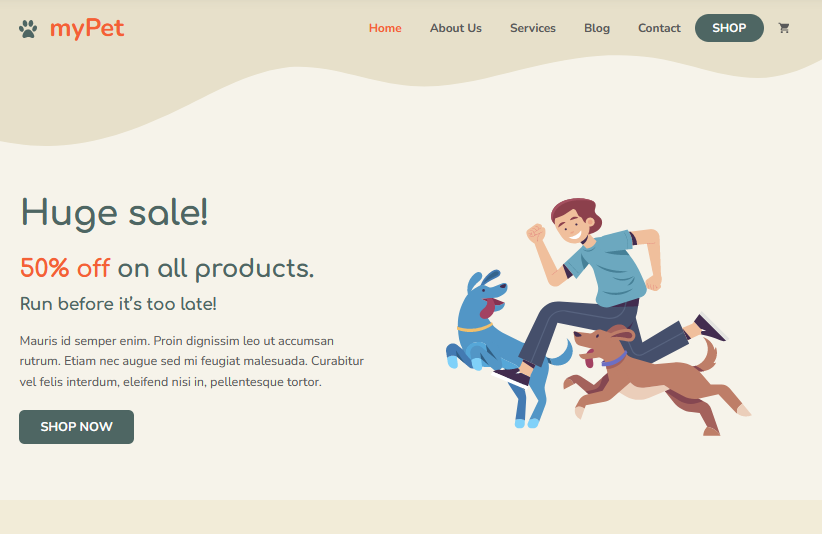
The Agency template is stylish yet simplistic, perfect for agencies, designers, and creatives:
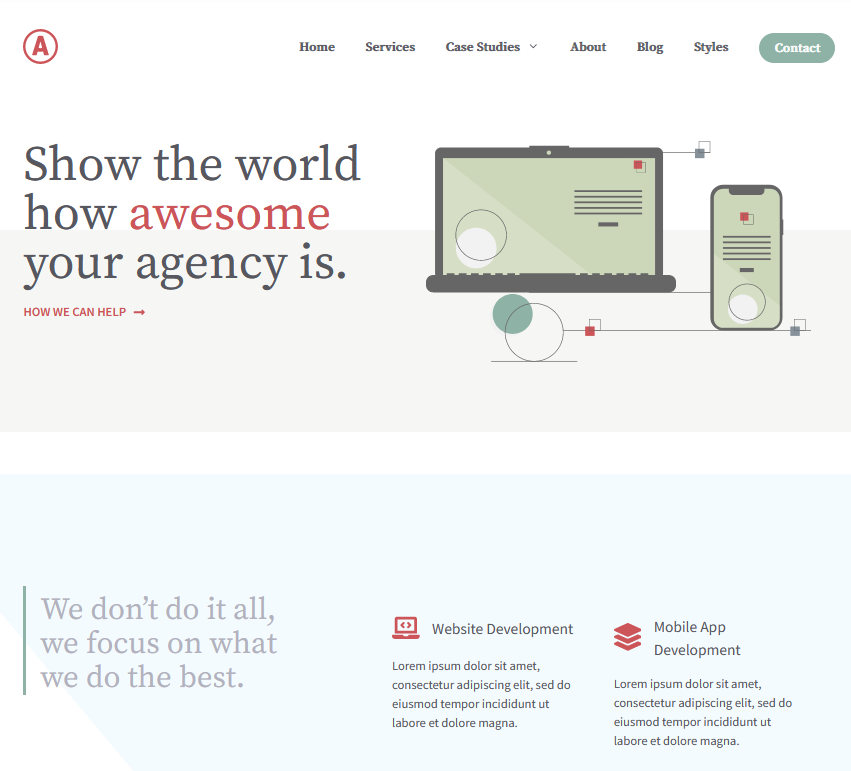
But that’s not all. GeneratePress is designed with customization in mind. It’s the web designer’s secret toolbox, only anyone can use it.
In short, however you want your minimalist website to look, it’ll be a breeze with GeneratePress.
And if you wanted to stick with the free version, the default design is as minimal as they come.
If you’re set on GeneratePress, try out this free WordPress theme and upgrade to unlock the premium features.
3. Blogasm by Precise Themes – Elegant and Minimal Theme for Creative Bloggers

This modern and elegant theme by Precise Themes is the perfect choice for bloggers and writers.
If you’re looking for a minimalist WordPress theme in fashion, food, lifestyle, travel, or photography niches, then it’s worth a look.
There’s also a demo template specifically named Minimal, featuring a mosaic-style blog post layout with lots of white space.
All the demo templates can be installed with the one-click demo installer. Each template includes only the most necessary elements, emphasizing what’s important.
Moreover, Blogasm has some unique features that make it a pleasure to work with:
- There’s a header slider to display videos or images and 4 different buttons styles
- It has many pre-made menu header templates, all aesthetically pleasing
- There’s a built-in popular blog posts widget for related post display
- And a range of different blog layouts
All Precise Themes have clean and minimal layouts, they’re easy to customize and well-optimized for SEO.
You can try out the Blogasm theme in their free theme or upgrade to Pro for $49 to get all the available features.
4. Blocksy – Multipurpose Theme with Free Minimalist Templates
Blocksy is another multipurpose theme that can be used for a variety of websites. That means it has settings that can be adjusted to suit the look and feel you desire.
Not only that but there are plenty of ready-made templates you can use for free.
Some minimalistic templates have really attractive designs that can be imported with a few clicks.
Here are a few of the minimal templates available:
Yogi is a template for Yoga instructors or anyone who holds classes for students. It’s spacious and uses a pleasant color palette:
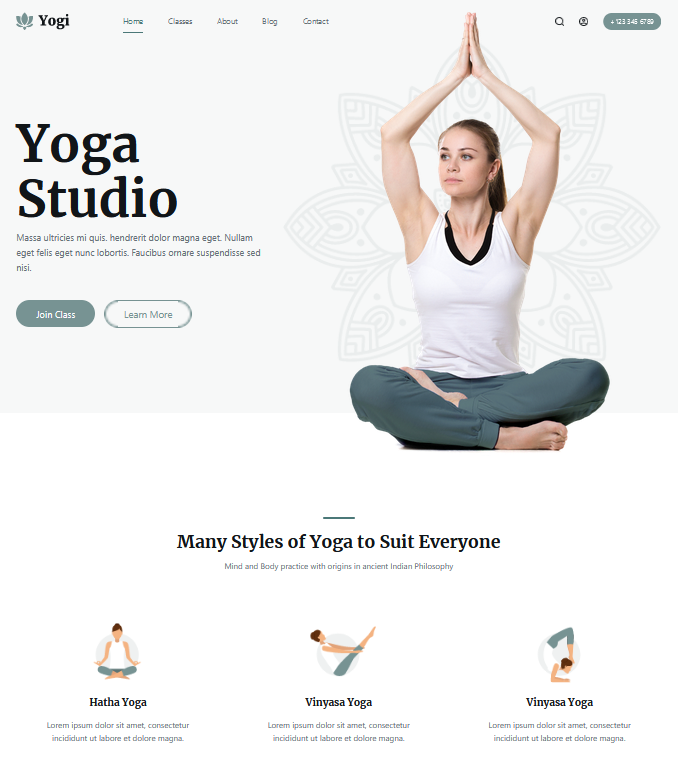
Web Agency has some extra details, like shapes and gradients in the background, but it’s subtle enough to still feel minimal:

Floreo is a stunning WooCommerce template for selling plants or anything similar:

The best thing about Blocksy is the ability to make unlimited customizations imaginable.
Its theme customizer has an intuitive theme options panel, making it easy for anyone to custom-design a minimal layout.
Furthermore, Blocksy has an advanced header builder with many elements to choose from to make your menu areas 100% unique (you can learn more in our full Blocksy review).
Other great features of Blocksy Premium include:
- White label if you want to use it for client sites
- Create custom sidebars for separate pages
- Custom Fonts, Google Fonts for GDPR, and Adobe Typekit fonts
- A built-in custom code snippets feature
- Works perfectly with Brizy, Elementor, and Beaver Builder
Grab the premium version for only $49 per year for a single site license.
5. Pile by Pixelgrade – Minimal WordPress Theme for Creatives and Designers

Pile by Pixelgrade is a stunning minimal theme for creatives and designers.
It has fullscreen headers with parallax features and you can showcase your work in unique ways.
Pages also have transition effects that make navigating the site feel inspiring and memorable.
Additionally, you can easily customize fonts, colors, and the layout as you see fit.
There’s also a unique page builder to create an online portfolio in just a few clicks.
This gives you full control to display your art or creative projects on your site however you like.
Take a look at Pile and other Pixelgrade themes here.
6. Lilium by Neuron Themes – Minimal Theme for WooCommerce

Lilium is one of the best minimalist WordPress themes for WooCommerce.
There are twelve templates to choose from, a product builder to design intricate product pages, product quick view, wish lists, and more.
The Minimum Store template presents a wide full-width layout, striking visuals, and delicate fonts.
Yet, all 12 templates share simplicity and avoid clutter.
The Lilium theme is ideal for anyone selling beauty products and the like. It’s created by Neuron Themes, who is a well-trusted theme developer.
Take a look at the theme demo and grab a copy for $69 per yearly license.
7. Timber by Pixelgrade – Unique and Minimal WordPress Theme for Photographers

Timber is an extremely creative theme for photographers or anyone who wants to display portfolios or image galleries.
It offers a multitude of unique layouts to showcase photos and videos with text in various combinations.
It’s like an interactive photo gallery, making it a pleasure to browse the site.
Pages transition with stunning visuals, adding a deeper creative aspect to the art of photography.
Moreover, Timber is fully compatible with WooCommerce so the site owner can sell their work in confidence.
This premium theme has all the capabilities to display artwork or photos with ease.
8. Envy Blog by Precise Themes – Minimal Theme for Fashion, Travel, or Food Bloggers
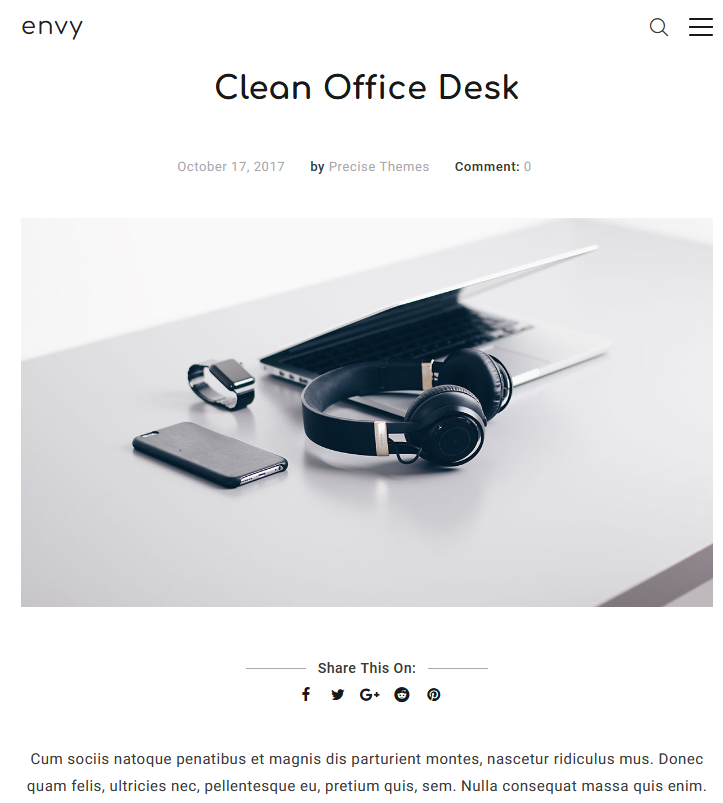
Envy is a crisp and fresh theme with dainty details. It’s easy to navigate, very clean, and offers lots of white space.
It’s designed for bloggers but supports WooCommerce too.
There are 10 different blog layouts with a range of post-layout variations.
It’s ideal for niches in fashion, magazines, travel, food, fitness, photography, music, decor, and more.
Additionally, it has 7 pre-made hero header layouts for use with background images or video, and different button types.
Lastly, you won’t be short on fonts, as there are over 750 available to choose from.
9. Elegant by Themify – Blog and Portfolio Theme

Elegant is truly stunning with lots of white space, a pale color palette, and beautiful font combinations.
It’s a multipurpose theme with several ready-to-go templates. And it’s fully compatible with WooCommerce.
It has a masonry or grid blog layout and a portfolio post type for adding custom image galleries.
You can design every single post, portfolio, and page in any way you need, using the Themify drag-and-drop builder.
Another interesting touch is the custom image filters. These allow you to add grayscale, blur, and sepia filters, similar to the editing features you see on Instagram.
This attractive theme is great for anyone designing a blog or portfolio site with eCommerce features.
10. Kraft Minimal Portfolio by CaliberThemes at ThemeForest
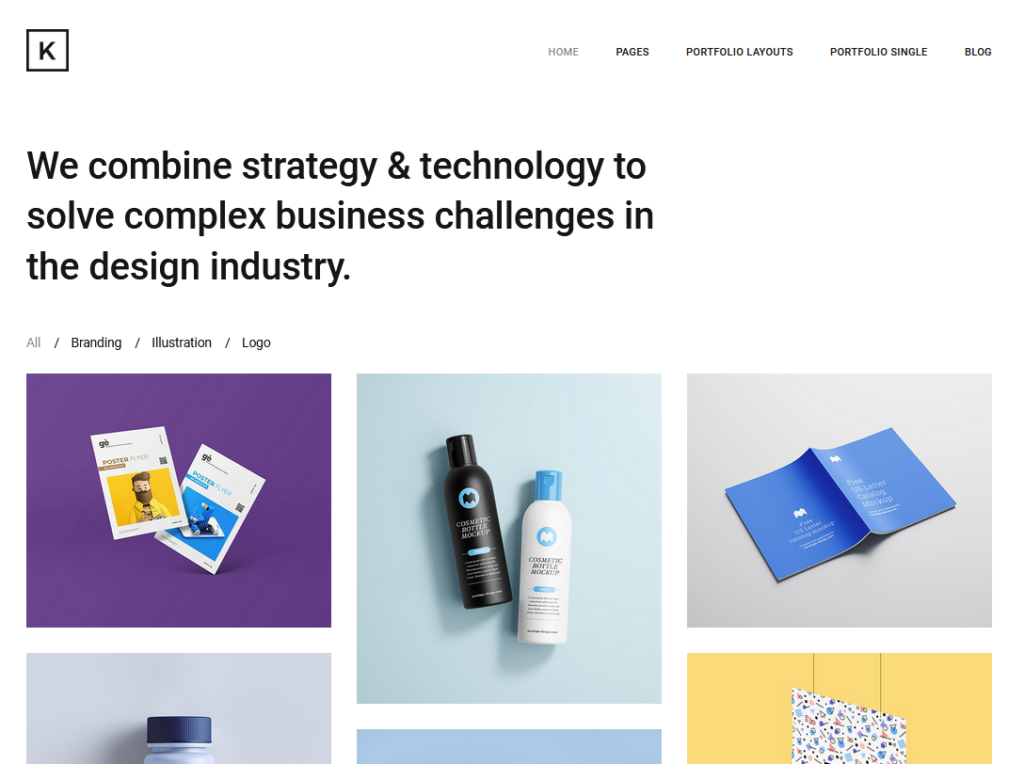
This super simplistic theme by Caliber Themes has everything you need to create a portfolio.
Whether you’re a photographer or graphic designer, Kraft lets you display your work elegantly.
There are 6 different home page layouts, image hover effects, and portfolio category filters.
11. Simple Persona Pro
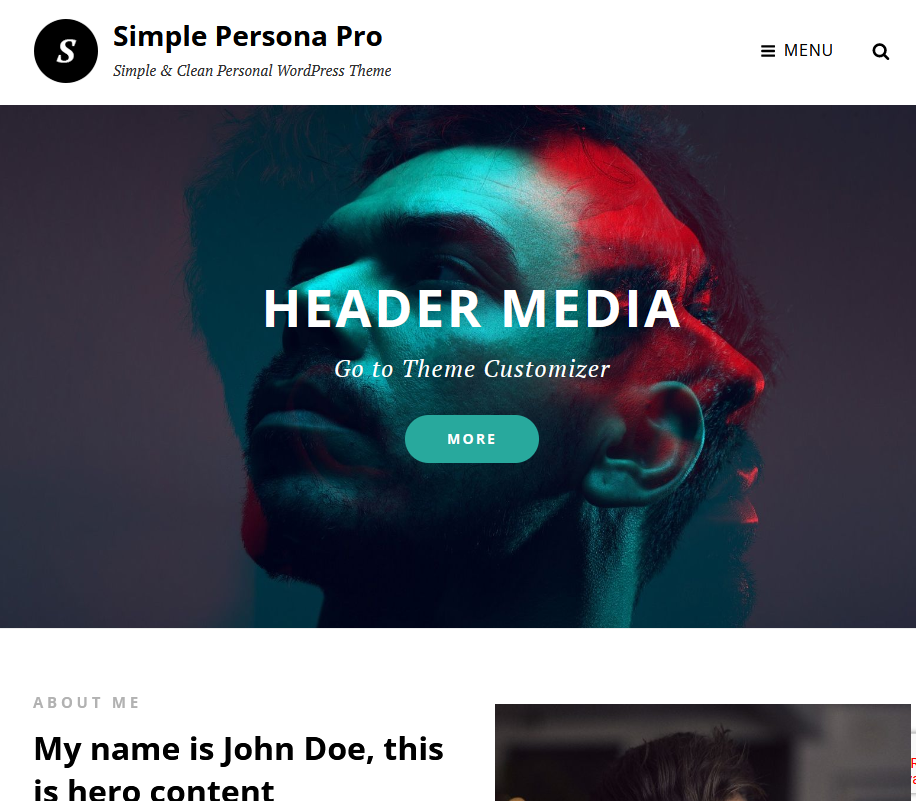
Simple Persona is a personal blog theme by CatchThemes with a very cool and professional style.
It’s super modern and minimal in design and it’s easy to customize everything.
The main features include:
- A portfolio
- Upcoming events
- Testimonials
- Featured blog posts
- Hero header content
- And has full compatibility with WooCommerce
There’s a free version and you can upgrade to the premium version for $59 for an annual license.
12. Monochrome Pro by StudioPress
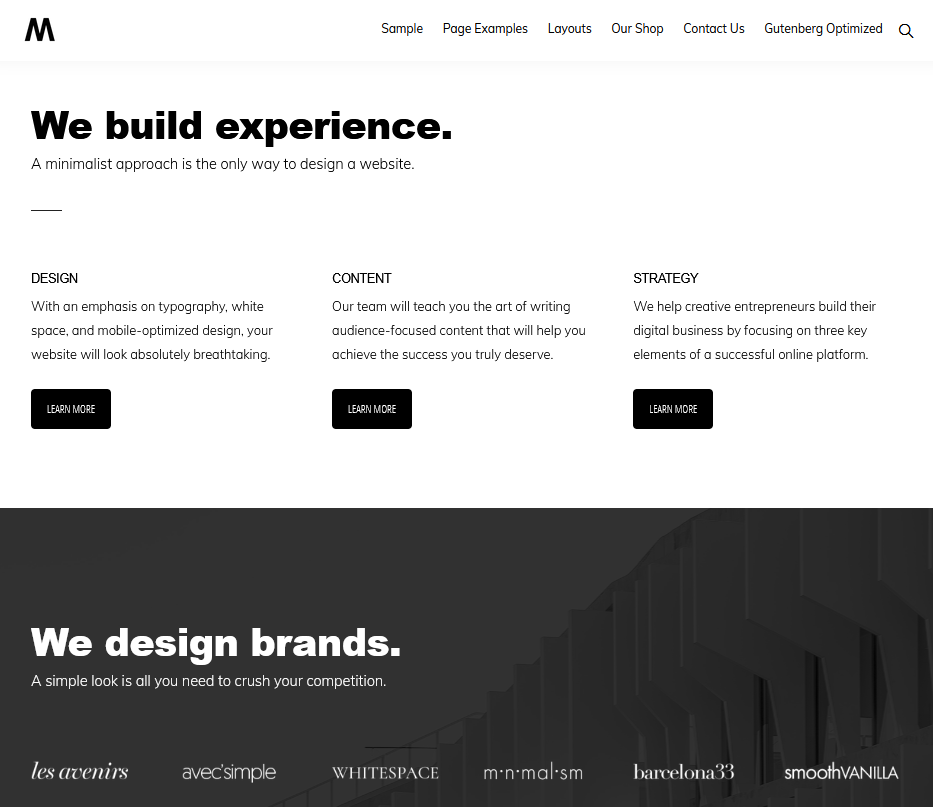
Monochrome by Studio Press is the epitome of minimalist design, yet it packs a strong and bold punch.
If you’re looking for a visually strong presence for a theme with masculine vibes, this could be the theme for you.
It’s optimized perfectly for Gutenberg and includes all the design elements for an online store with woo commerce.
Plus, a Studio Press membership gives you access to all Genesis themes.
13. Maktub – Minimal & Lightweight Blog
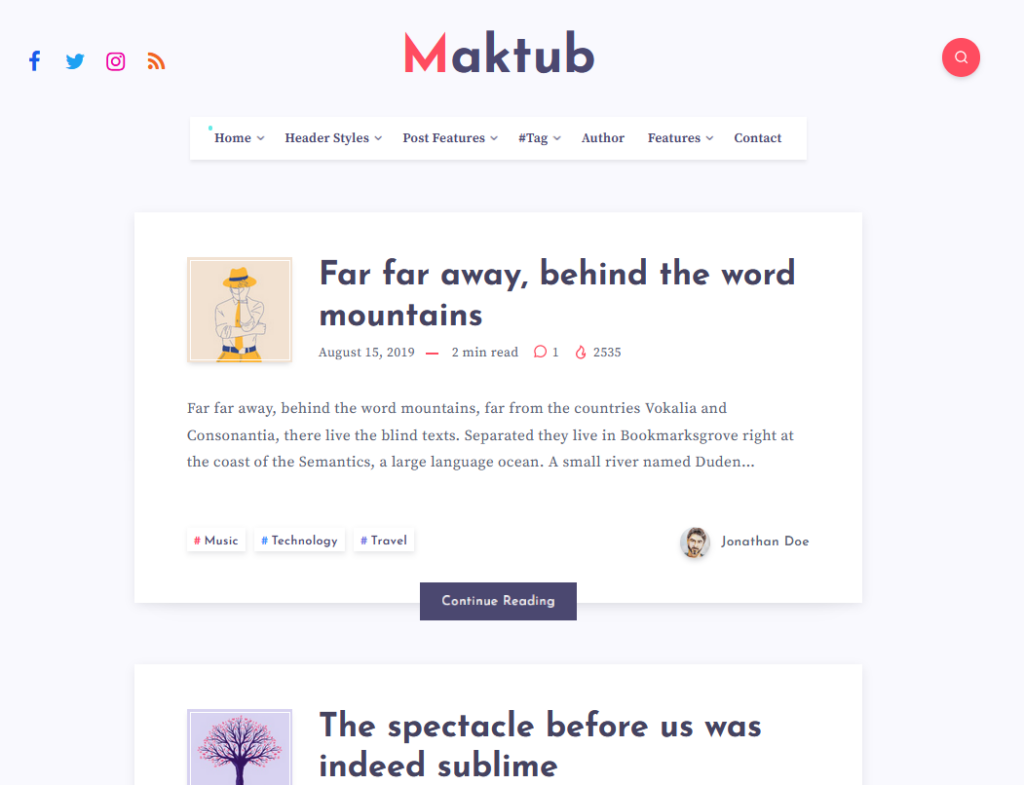
Maktub is a super lightweight and unique-looking theme sold on ThemeForest.
The first thing you notice is its pastel color palette and interesting font choice.
Its clean and individual style is perfect for bloggers with a creative mind and a passion for writing.
14. Dixie by SecondLine Themes

If you’re looking for a minimal theme specifically designed for podcasters, then Dixie could be the right one for you.
Compatible with PowerPress and SeriouslySimplePodcasting, you’re able to share your podcast on your site with the built-in podcast player.
The player has a sleek design and you can also host audio files locally from your WordPress media library.
There are a lot of theme options and its modern design will suit a wide range of niches.
15. Neve by Themeisle

Neve is one of the most popular and respected WordPress themes on the market today.
This multipurpose theme will cater to anyone from agencies and bloggers, to eCommerce sites, recipe blogs, and NFT illustrators.
There are plenty of templates to choose from too, many of which hold the title of minimalism.
Neve is fast and lightweight, works with popular page builders, and offers fantastic support from the Themeisle team.
16. Ellada – Elegant Photography Theme by Neuron Themes
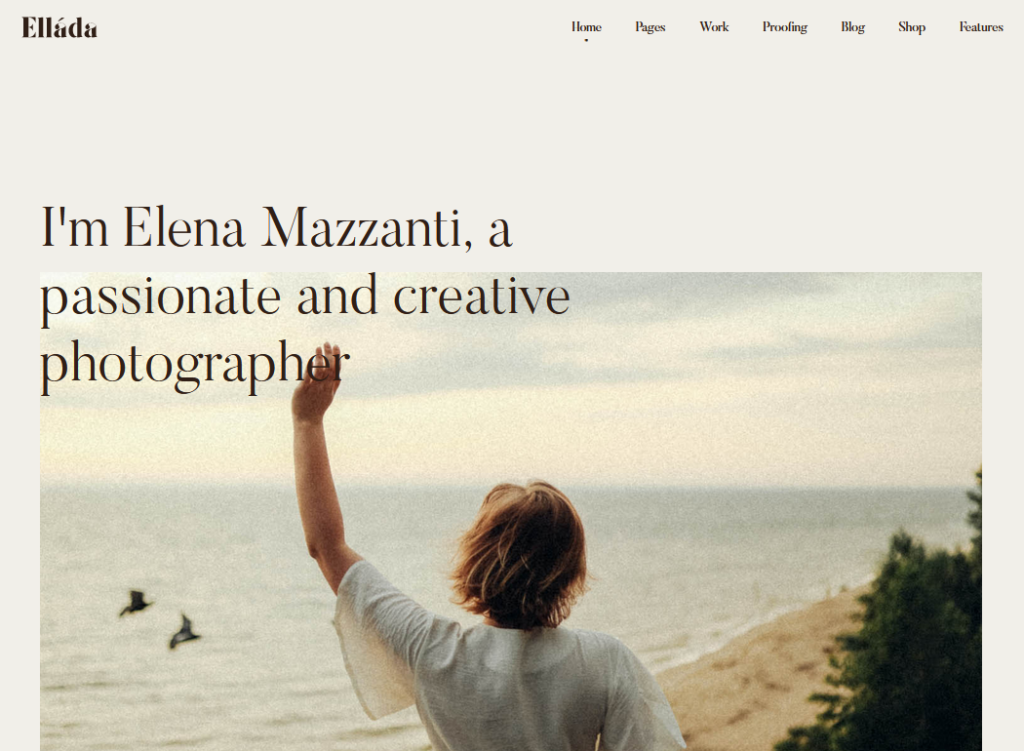
This photography theme is extremely versatile, providing endless variations of layouts and functionality.
From full-screen sliding images on scroll to simple mosaic-style gallery and blog layouts.
Ellada is the ideal theme for anyone from photographers, creatives, and agencies, to wedding photographers, and fashion bloggers.
17. Solopreneur Blogging theme by Fancy Themes
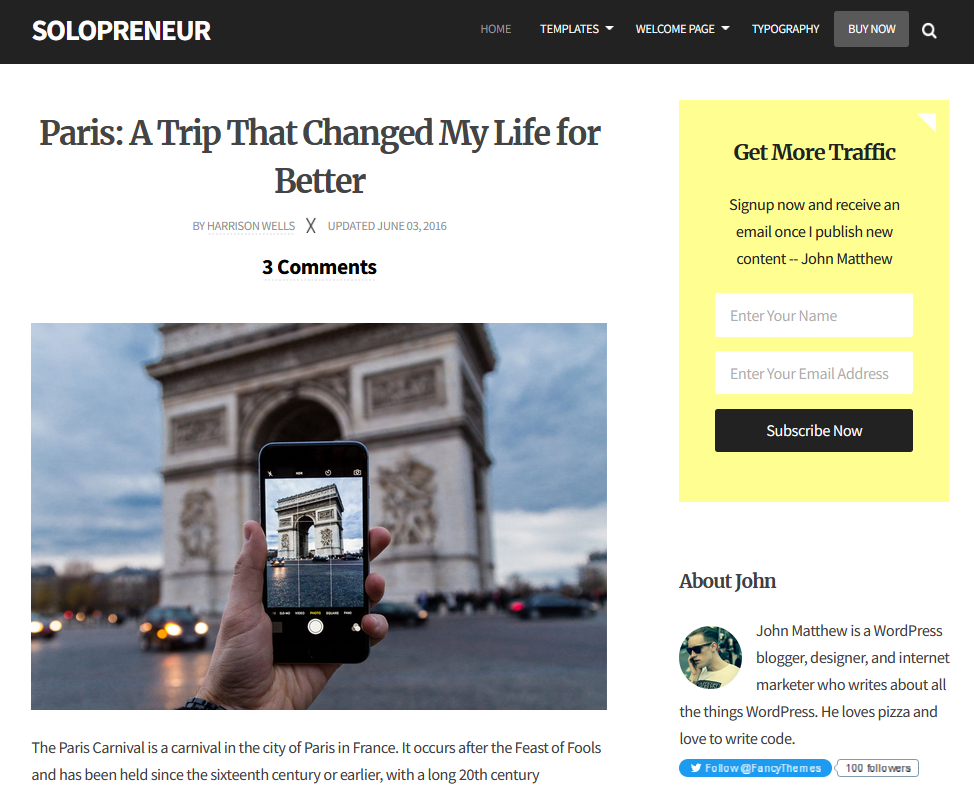
This minimal theme by Fancy Themes is specifically designed for the solopreneur blogger. And it comes complete with two high-converting landing pages.
Its high contrast design offers a clean and bold appearance, inspiring ambitious high achievers and the like.
With lots of customizations available, you’re able to make your site your own and focus on sharing valuable content with your audience.
18. Veen – Minimal Lightweight AMP Blog for WordPress
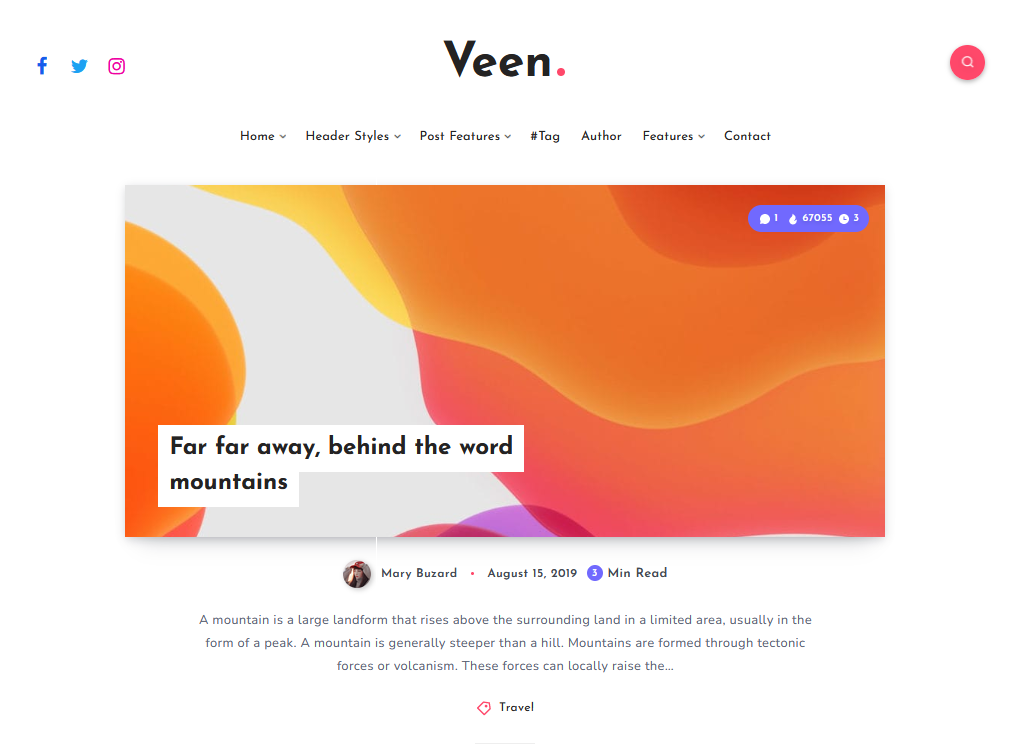
Veen is a stunning and colorful theme made for personal, travel, and photography, bloggers with a passion for style and design.
There are several layout options with features such as visitor counts and average read time on blog posts.
With lots of white space and attention to fine details, Veen is a statement theme for bloggers wanting to make an impact.
19. Chronus by Themezee

Chronus is a very cool and stylish theme designed for personal and news-type blogs.
Key features include top navigation for custom menus with social media icons and custom widgets for a magazine-style look.
There are plenty of settings to customize the look and feel, however, the general style is more on the masculine side.
In short, Chronus is a fast and lightweight premium WordPress theme with tons of options at a low price.
20. Pepper+ by Artisan Themes

Pepper+ is described as “Spicy with a dash of elegance”, and I’d have to agree.
This stylish and minimalist theme has character and a set of design features you’ll fall in love with.
Modules let you create custom layouts without needing to code anything and there are lots of ready-made templates you can choose from.
The pricing for Artisan Themes is a little higher than most, but you get what you pay for.
21. Ginea by Neuron Themes Modern WooCommerce Theme

Ginea is the perfect theme if you’re creating an eCommerce store for fashion, clothing, furniture, or apparel.
This elegant WooCommerce theme has lots of templates available, so it’s easy to get things up and running.
Website visitors will be impressed with the professionalism and class, no matter which template is used or customization implemented.
22. ArtsyLens Pro by Catch Themes
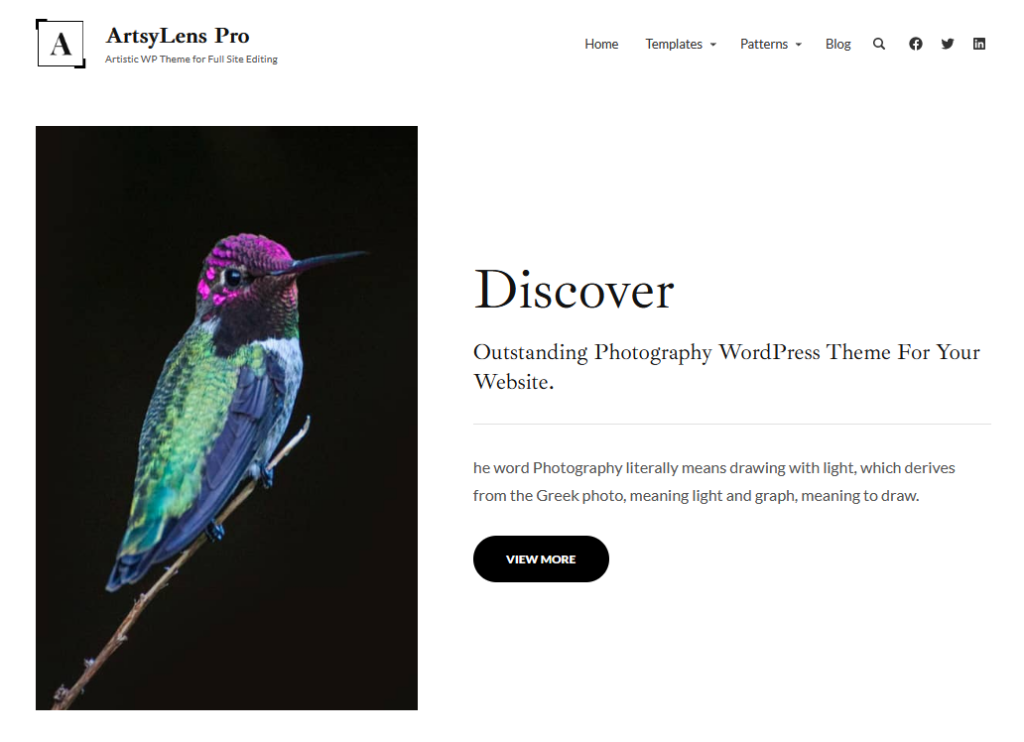
ArtsyLens is a stunning theme to showcase artwork or photos elegantly. It’s one of the best minimal WordPress themes for photographers.
It’s a block theme, meaning everything is done using the Gutenberg editor.
There are 23+ available block patterns, hero content, portfolios, testimonial sections, and much more.
Pricing is $59 and there’s also a free version available if you want to try it out first.
23. Maximalism by dessign.net

Maximalism has the most elements going on, yet somehow, still pulls off the minimalism status.
This very cool theme is perfect for the magazine-type blogger who wants something fresh and something simple.
On the home page, you have a full-width hero sliding header, an image gallery, and the ability to showcase your Instagram pics.
Created by Dessign, you can pick up Maximalism for $59 or get access to all of their themes for a fraction more.
24. Litho Multipurpose Elementor WordPress Theme
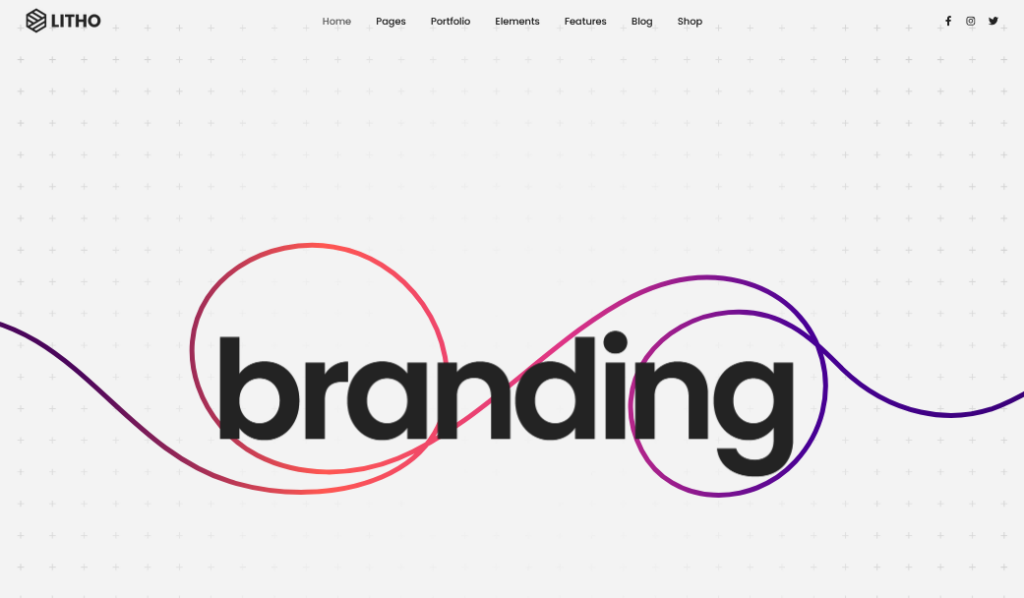
Litho has a template called Branding Agency, which has a clean, professional, and minimal design.
In fact, many Litho templates are minimalistic in design and they are all very easy to modify as they use Elementor.
Branding Agency uses big and bold fonts, full-width sections, interactive elements, and a subtle color palette.
It’s an ideal theme for any service-based business, marketing agency, or startup.
Litho is a multipurpose WordPress theme with over 300 templates and is available to buy on ThemeForest.
25. Challenger by Compete Themes

Challenger is a theme that also made it to the list of the easiest WordPress themes. That’s because it’s so easy to use and set up.
It’s minimal and simplistic, yet has features to collect emails and convert readers into subscribers.
It’s also super fast and lightweight, providing an optimal user experience for your readers.
26. Uniq
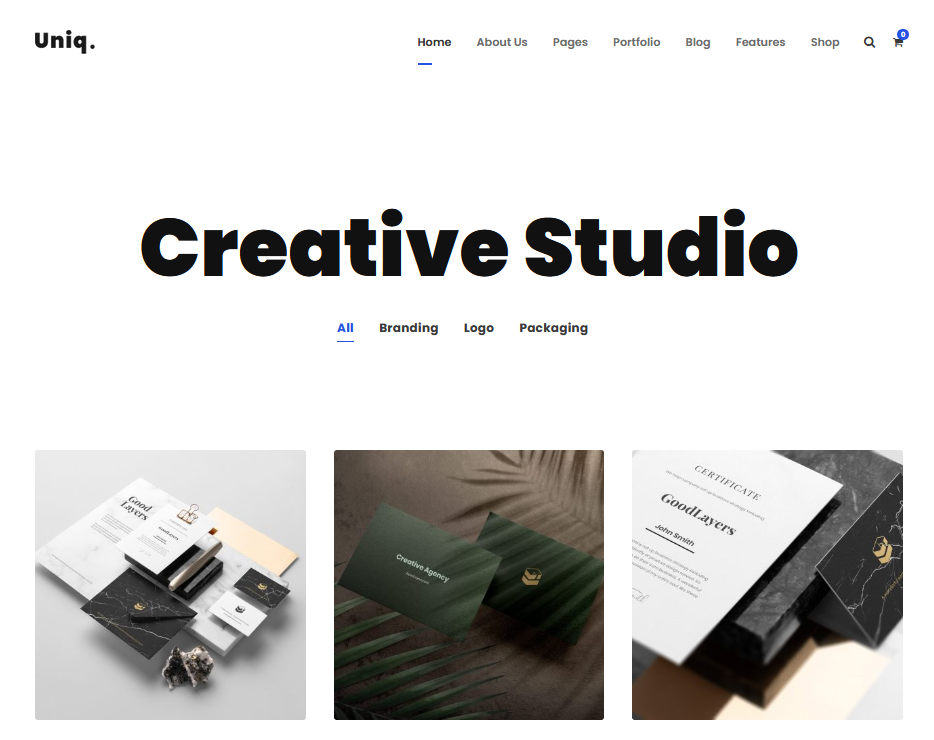
Uniq is full of creativity, elegance, and minimalism. It’s a multipurpose theme that lets you design to your heart’s content, without writing a single line of code.
There are tons of different styles available for the home page, inner pages, blog layouts, and portfolio designs.
This lets you combine an unlimited variation of designs to make your site one of a kind.
27. Conlectio by Neuron Themes

If you need a theme for an agency or portfolio website and want to make an impact, you’ll love Conlectio.
With several templates to choose from, each oozes creativity, maintaining minimalism and elegance.
It features very few colors, highlighting a strong contrast between text and background. Images stand out with full-width views and it’s fully compatible with WooCommerce.
28. Clean Portfolio Pro by Catch Themes

Creative people like photographers, bloggers, designers, and illustrators will love this theme because it’s designed with them in mind.
This beautiful design theme comes with lots of built-in features:
- Full HD screens
- Custom headers
- Featured content sections
- Testimonials
- Hero content
- Image sliders
It’s all in the fine details with this theme. It uses a minimal color palette and stunning fonts.
All of which can be customized to your preferences.
29. Typology – Minimalist Blog

Typology is a text-based blogging theme for people who want to focus on writing.
This strikingly elegant theme has very few bells and whistles, making it a pleasure to browse through.
It has a full-width hero header with customizable text and buttons and background colors.
And the main content area draws your attention to it with boxed shadows and beautifully chosen fonts.
30. Botiga by Athemes

Botiga is a minimal WooCommerce theme by Athemes with different product listing layouts and a quick view feature.
The product page has a variety of gallery views to showcase your products elegantly.
There are also options to customize the checkout page.
Moreover, its fresh and minimal design has lots of white space and plenty of options for customization.
31. Blog Feedly
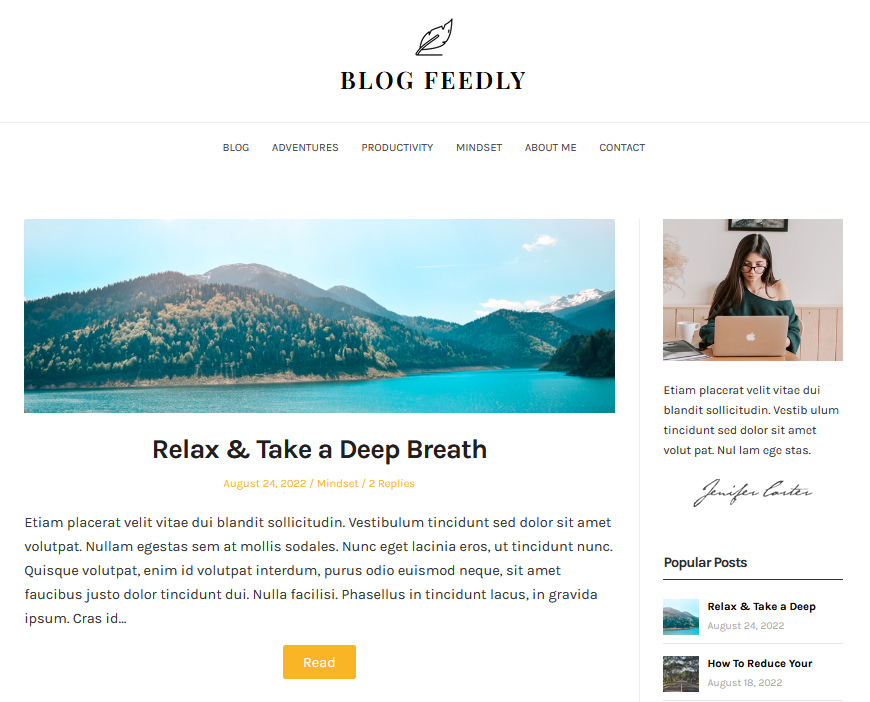
If you’re a blogger looking for something super basic, you can’t go wrong with Blog Feedly.
Even though this minimalistic theme is simple in design, it still offers some great features.
It’s lightweight, SEO-optimized, and perfect for writers who want to focus on writing.
The theme breathes simplicity, has four templates to choose from and you have the ability to customize everything.
Moreover, it’s easy to set up with the one-click install and is also compatible with Elementor.
Conclusion: Minimalist WordPress Themes
There you have it. If you want to choose the best minimalist WordPress theme, you’ll surely find it on this list.
Most have free versions, but premium themes offer so much more.
If you’re in a rush, an excellent choice is to go with Astra. There are endless templates and an impressive set of features.
WORDPRESS
10 Best Technical Documentation Software for WordPress
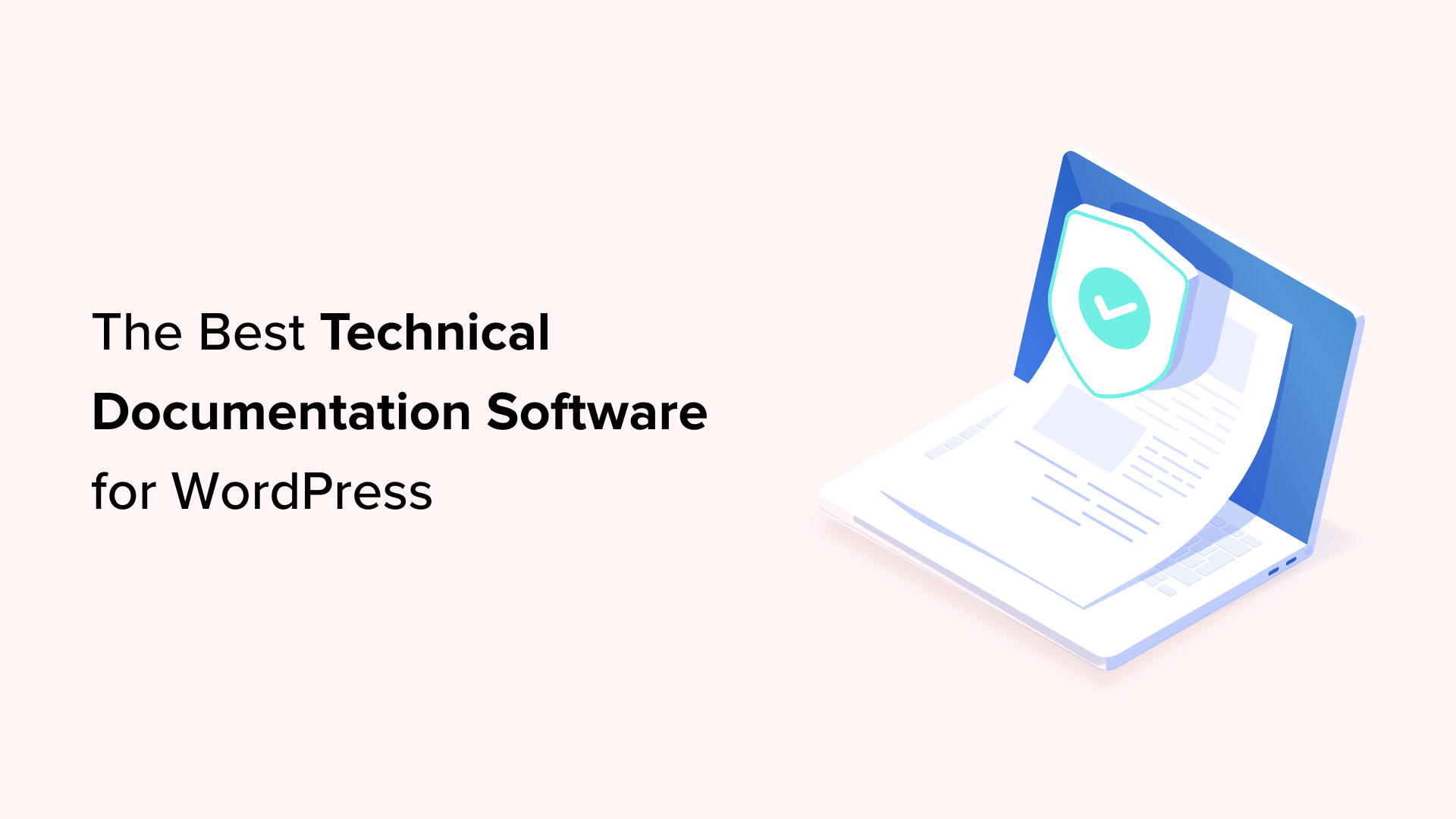
Are you looking for the best technical documentation software for WordPress?
Technical documentation software helps you easily write, edit, and manage documentation inside WordPress. This enables users to get the information they need without asking for support and helps you reduce support queries.
In this article, we’ll show the best technical documentation software for WordPress that you can use for your business.
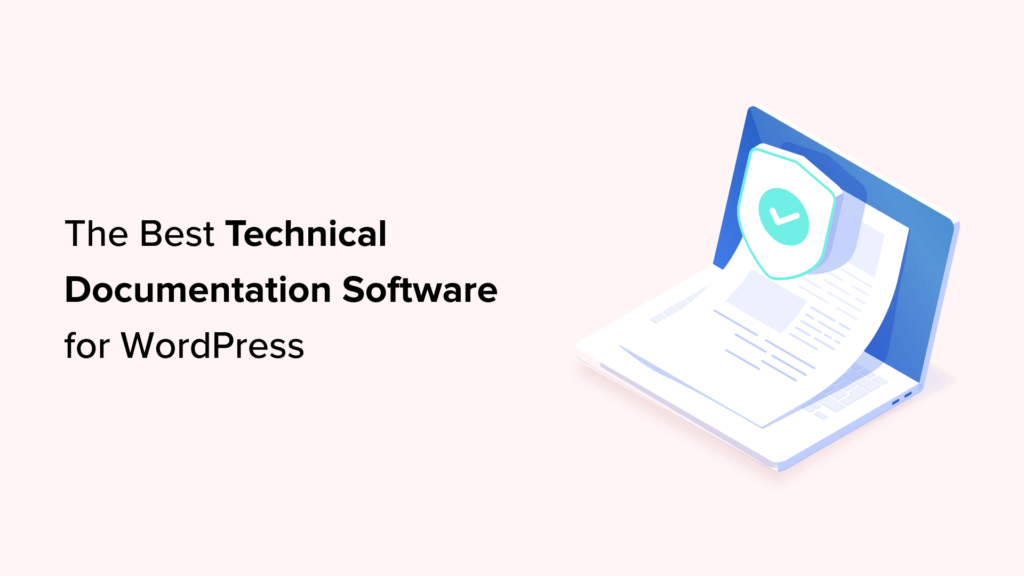
Why Use Technical Documentation Software for WordPress?
According to Harvard Business Review, over 81% of customers try to take care of issues themselves before contacting a support representative.
If customers cannot find quick answers to their basic questions, they are likelier to leave a negative review, ask for a refund, or find an alternative.
By using technical documentation software, you can provide your customers with the information they need without reaching out for technical support via contact form or phone support.


The following are some of the top reasons for using technical documentation software for your business:
1. Saves You Time + Money: With a handy documentation section, your support team spends less time answering the same questions repeatedly. Many customers find answers before even opening a support ticket. By being more efficient, you can keep your support team small and save money.
2. Improves Customer Satisfaction: Getting quick answers makes your customers happy. It also gives them the satisfaction that they can find reliable information when needed.
3. Builds Trust and Brand Loyalty: Satisfied customers are likelier to leave positive reviews about your business and recommend it to others. This trust leads them to buy more products from your business in the future.
4. Adds a 24/7 Support Rockstar to Your Team: Think of technical documentation as a support team member who works 24/7 at no additional cost to your business. It is always available, other team members can use it frequently, and you can always add new information to it.
How to Add Technical Documentation in WordPress
A WordPress website comes with two common content types: posts and pages.
Posts are published in reverse chronological order, making them less than ideal candidates for technical documentation articles. Pages are standalone content types and can be used to create technical documentation.
However, ideally, they are best suited for your business pages (services, storefront, about page, landing pages, and more).
This is where technical documentation software for WordPress comes in handy.
These tools are separate plugins or themes that add a Knowledge Base or Documentation content type to your WordPress website.
Among these tools, you can choose from several excellent options.
That being said, let’s look at the best technical documentation software you can use in WordPress.
1. Heroic Knowledge Base


Heroic Knowledge Base is the best WordPress technical documentation software on the market.
It allows you to easily add technical documentation in WordPress and sort it into categories and tags. There is no complicated setup involved.
The front end displays your documentation in an easy-to-browse layout with a prominent search bar at the top. You don’t need to write any code to get it working on your website.


The live search feature uses Ajax to show answers when users start typing. This helps your customers get to the answers much faster.
Most importantly, it works with any WordPress theme and will use its own custom templates to display the knowledge base area. This is perfect if you want to use it on your business website.
Heroic Knowledge Base also comes with a support assistant bot, which appears across your website and provides instant answers when users click it.


Want to know what your customers are struggling with? Heroic Knowledge base comes with analytics to help you gain insights into user behavior.
Pros of Using Heroic Knowledge Base
- Easy to use without any complicated setup.
- It works with any WordPress theme and can be used on an existing WordPress website.
- The live search feature helps users find articles more quickly.
- Built-in analytics allow you to track which parts of the documentation are accessed by more users, providing insights into improving your products.
- Includes a support assistant bot to help users quickly find answers
Cons of Using Heroic Knowledge Base
- It is a paid plugin with no free version. However, they do offer a 14-day risk-free money-back guarantee.
- License renews at regular pricing, which is a bit high. However, you can choose to cancel your subscription and keep the plugin.
Why We Chose Heroic Knowledge Base: Heroic Knowledgebase is the most comprehensive and easy-to-use technical documentation software for WordPress. It works with any WordPress theme, which means it can be easily used on your existing WordPress website.
We already use it for the documentation hub on the WPForms website, and our documentation team loves it.
Pricing: Starting from $149.50.
2. Groove
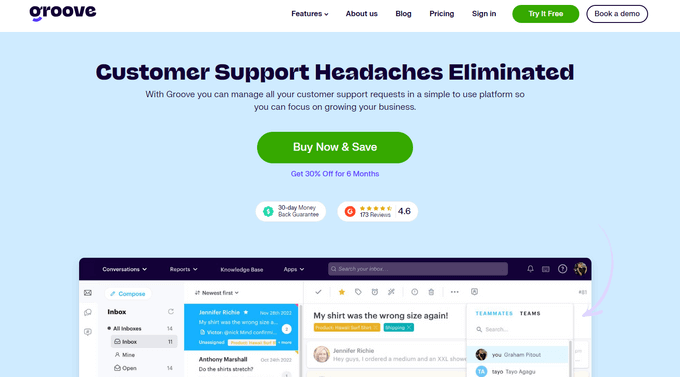

Groove is a powerful customer support platform that combines a knowledge base, a help desk, and live chat into one solution.
It is easy to use, and you can use it under your own domain name.
It comes with an easy design tool that allows you to choose your brand colors and upload a logo. Plus, the knowledge base pages look great on all devices and screen sizes.
Groove Knowledge Base also provides valuable insights such as article performance metrics, most searched terms, and most viewed articles. It can even make article suggestions.
Pros of Using Groove
- Easy to use and manage.
- Requires no special skills.
- It can be used alongside Goove’s customer support platform with shared inboxes, live chat, and help desk software.
- Help icon on every page, allowing users to quickly search the knowledge base and seamlessly transition to customer support.
- Customizable mobile-friendly themes.
Cons of Using Groove
- It can be a little more expensive than some software on the list.
- Data is stored on Groove servers instead of your WordPress website.
Why We Chose Groove: Technical documentation is where a customer’s support interaction begins, and they may need further help. This is where Groove can help you seamlessly transfer customers to support inboxes or live chat.
In our experience with Groove, we like its ease of use, simple interface, and self-serve widget, and how it easily integrates into every page of your website.
Pricing: Starting from $4.80 per user per month.
3. KnowAll
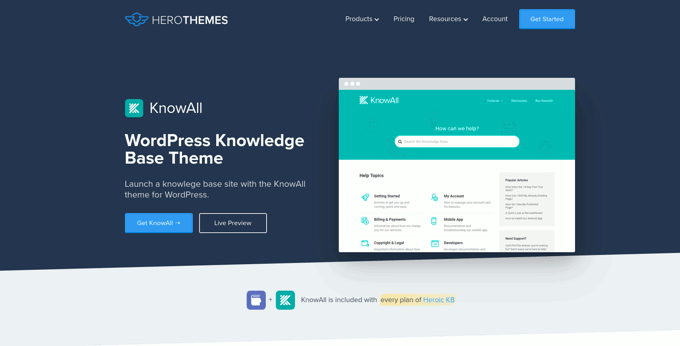

KnowAll is the best WordPress knowledge base theme on the market. It comes with the best WordPress technical documentation plugin called Heroic Knowledgebase.
It is the perfect solution if you are building a separate website to handle support for your business. In that case, you can use KnowAll to set up a fully functional documentation center instantly.
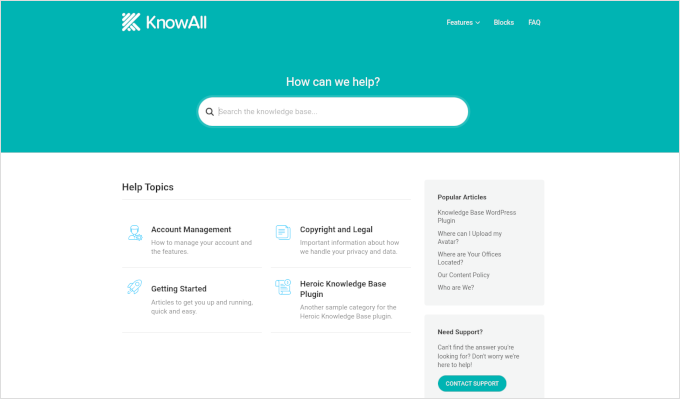

Pros of Using KnowAll
- Suitable if you want to make a separate website for support and documentation.
- You can customize it like any other WordPress theme.
- As a classic theme, it supports the Theme Customizer, widgets, and navigation menus.
- Comes with Heroic Knowledgebase blocks, which you can use anywhere on your site.
Cons of Using KnowAll
- It is a WordPress theme, so it wouldn’t be a good solution on a site where you are already using a different theme.
Why We Chose KnowAll: Some businesses may want to set up a separate WordPress site for support documentation. In that case, KnowAll is a ready-to-go solution that provides everything they need. Plus, it comes free with the Heroic Knowledge Base plugin, which, as mentioned, is the best technical documentation software for WordPress.
Pricing: Free with Heroic Knowledge Base plugin, starting from $149.50.
4. BetterDocs


BetterDocs stands out as a reliable WordPress knowledge base plugin, offering a blend of user-friendliness and extensive features.
It comes with pre-designed knowledge base templates tailored to work with any WordPress theme. It also integrates with popular WordPress page builders through additional widgets.
Pros of using BetterDocs
- A simple and easy-to-use technical documentation plugin for WordPress, suitable for beginners and experts alike.
- Includes pre-designed templates to work with any WordPress theme.
- It comes with additional widgets that can be used with page builder plugins.
Cons of using BetterDocs
- Using it with your existing WordPress theme may require some additional tweaks.
Why We Chose BetterDocs: We found BetterDocs to be a great tool for creating technical documentation in WordPress. It is easy to use and makes it easy for your users to find the answers using an excellent live search feature.
Pricing: Starting from $55 for a single site license.
5. weDocs
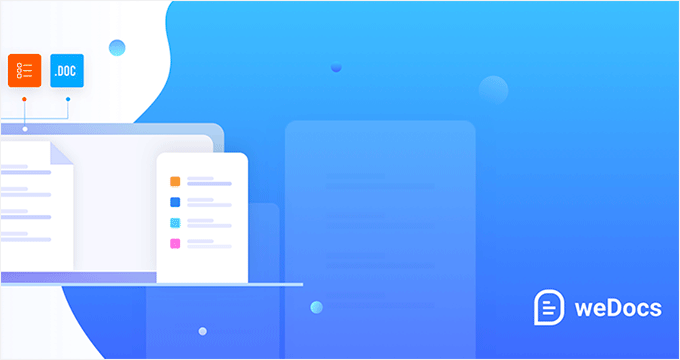

weDocs is another powerful solution for creating technical documentation in WordPress. It is easy to use and allows you to add a docs section to your existing website or a separate support website.
It includes a search feature and allows you to organize documentation in a hierarchical format. You can also use tags to sort articles into topics and subtopics. You can also sort articles with a drag-and-drop interface.
Pros of Using weDocs
- It works with existing WordPress websites and can also be used on a standalone support website.
- It lets you organize documentation in a hierarchical format. Plus, you can use tags to sort articles into topics.
- It has a drag-and-drop interface to organize documentation pages.
- Comes with an AI assistant built with ChatGPT to show relevant information automatically.
Cons of Using weDocs
- It does not come with a separate theme but has built-in templates to work with any WordPress theme. This may require a little bit of tweaking, but nothing too tricky.
Why We Chose weDocs: It is a good option if you want to organize documentation in hierarchical pages. The drag-and-drop organizer allows you to easily set up documentation architecture.
Pricing: The base plugin is available for free. Pro plans start at $47 / year.
6. Echo Knowledge Base
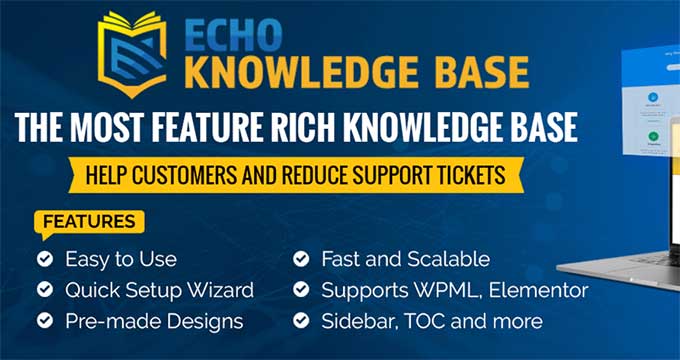

Echo Knowledge Base makes creating and managing documentation, FAQs, and articles easy and organized.
It has a user-friendly interface, and you can easily add, edit, and organize your content without technical know-how.
Pros of Using Echo Knowledge Base
- Allows you to organize support articles with categories and tags.
- You can use AI assistance to help write and answer questions.
- It includes multiple layout styles and shortcodes to add FAQs and support content across your website.
Cons of Using Echo Knowledge Base
- A little less beginner-friendly than other solutions on the list.
- The base free plugin doesn’t have good search experience. You’ll need to buy a paid add-on separately to add advanced search.
Why We Chose Echo Knowledge Base: If you are looking for a free solution, then Echo Knowledge Base can be a good option. It provides a good base to add documentation and you can always purchase a bundle to add more features if needed.
Pricing: The base plugin is free. You can buy add-on packs starting from $46 / year.
7. BasePress
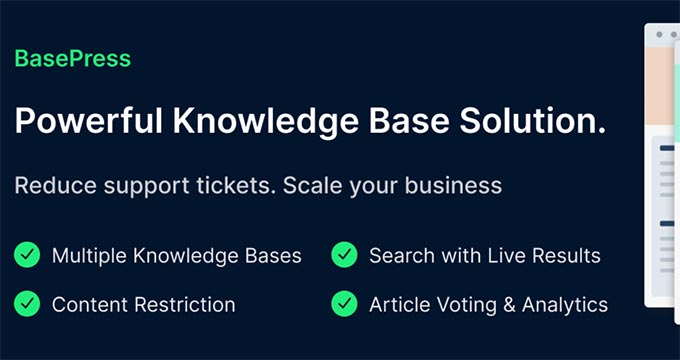

BasePress is another simpler and easy-to-use plugin that helps you create professional-looking documentation pages and a knowledge base for your website.
It has three customizable themes, allowing you to create a visually appealing support center with minimal effort.
The advanced instant search bar helps users find answers quickly, while the drag-and-drop interface makes organizing articles into sections, categories, and tags easy.
Pros of Using BasePress
- It allows you to create multiple knowledge bases.
- Comes with article voting and analytics.
- Content restriction lets you choose who has access to documentation.
- Instant search lets users find answers quickly, you can add the search bar anywhere on your site using a shortcode.
Cons of Using BasePress
- The built-in templates may require some tweaking to work alongside your existing WordPress theme.
- Features like article voting, an advanced search bar, table of contents, etc. are available under paid plans.
Why We Chose BasePress: If you are looking for a basic free technical documentation plugin, then BasePress could be a good solution. However, if you need the features available in its premium version, you should compare it with other paid solutions on this list.
Pricing: The lite plugin is free. Pro plans start at $79 / year.
8. HelpCrunch
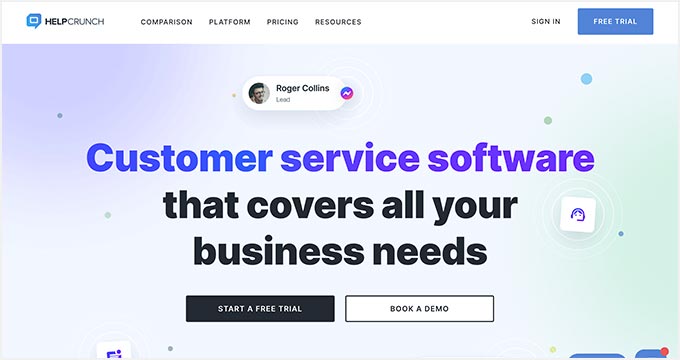

HelpCrunch is a multi-purpose WordPress technical documentation plugin that allows you to easily create a support website for your customers.
It allows you to organize your help documents into categories and tags easily. It also has a more accessible customizer that lets you choose the theme and background colors for your docs section.
Pros of Using HelpCrunch
- Offers a multi-channel customer support software with chat, email, and technical docs.
- Supports popular messaging apps like Facebook Messenger, WhatsApp, and Instagram to chat with customers.
- AI-powered live chat assistant helps customers find answers more quickly.
Cons of Using HelpCrunch
- It is a multi-channel, full-fledged customer support platform with email marketing, live chat support, and a knowledge base. If you are just looking for technical documentation software, this might be overkill.
- A bit pricier than other solutions on the list.
Why We Chose HelpCrunch: If you are looking for a knowledge base with built-in live chat support, then HelpCrunch can be a good solution for your business. It offers multiple ways for customers to seek help, which ensures customers can get the information they need.
Pricing: Starting from $12 monthly for each team member without emails.
9. VS Knowledge Base
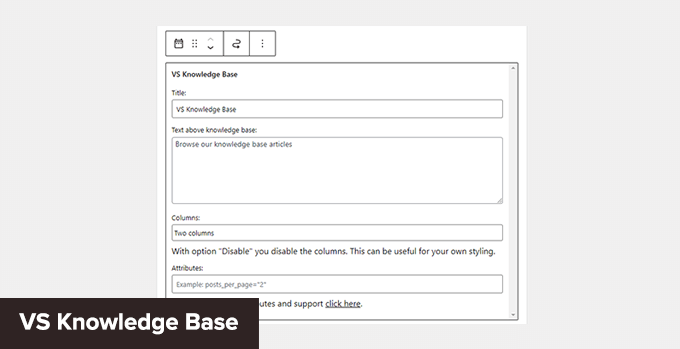

VS Knowledge Base is a very simple knowledge base plugin for WordPress. It is suitable for advanced users adding documentation on a separate WordPress installation in a subfolder or subdomain.
It does not come with its own knowledge base content type but can be used with any other content type, like posts or pages.
Pros of Using VS Knowledge Base
- Extremely simple and straightforward solution to create technical documentation in WordPress.
- Use shortcodes or VS Knowledge Base widget to display documentation.
- Works with any WordPress theme.
Cons of Using VS Knowledge Base
- Since it does not use a separate content type for knowledge base articles, it will not be easy to use on an existing WordPress website.
- It lacks advanced features that many other solutions on this list offer.
Why We Chose VS Knowledge Base: For businesses that want to set up a separate WordPress install on a dedicated support site, VS Knowledge Base can be a very basic and simple solution.
Pricing: Free.
10. BSF Docs


BSF Docs is a lightweight WordPress documentation plugin. It comes with a Docs content type for adding technical documentation articles.
It offers a very basic set of features which makes it quite easy to use. There is not much for you to customize, and you can just start adding your documentation.
Pros of Using BSF Docs
- A lightweight technical documentation plugin that is super simplistic by design.
- Comes with a basic template to display technical documentation sorted by categories.
- You can create documentation articles using the Docs content type or posts/pages.
Cons of Using BSF Docs
- Lacks many of the features that are available in some other solutions on this list.
- The default templating works with most WordPress themes, but you may still need some customization.
Why We Chose BSF Docs: If you need a free plugin to create and manage your technical documentation, BSF Docs is a good solution. It includes a very helpful live search feature and works quite well with any WordPress theme.
Pricing: Free.
Bonus Tools
Adding technical documentation alone would help reduce support requests. However, you may need additional tools to ensure your customers get the best support possible.
Combining your documentation with the following tools will help you create a robust customer support system.
11. Heroic Inbox
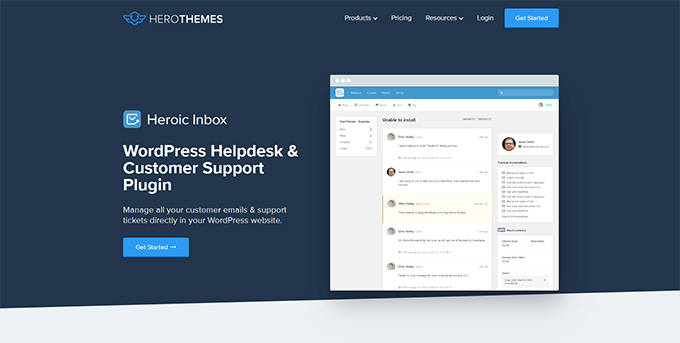

Heroic Inbox is a WordPress helpdesk and customer support plugin from the makers of KnowAll and Heroic Knowledge Base plugins.
It allows you to manage all customer support emails and tickets inside WordPress. You can create multiple mailboxes for support, sales, partnerships, and more from the same dashboard.
With built-in user management, you can assign different mailboxes to different team members and route customer emails to the right team.
Team members can add notes only visible to your team to share information and coordinate responses.
It also pulls all customer information in the sidebar next to a conversation. You can see past support requests and customer activity when answering a ticket.
Pricing: Starts at $199.50 for the standalone plugin. However, the real value comes with their bundle package, starting at $299.50, and includes Heroic Knowledge Base.
12. WPForms


WPForms is the best WordPress form builder on the market. It allows you to create forms in WordPress, including customer support forms, feedback forms, survey polls, and more.
WPForms lets you easily allow your customers various options to contact and provide feedback. This helps you make data-driven decisions, leading to more customer satisfaction.
WPForms is a no-code solution and comes with a drag-and-drop form builder. It includes over 1600 templates for all kinds of forms your small business might need.
Pricing: Starting from $49.50. There is also a free version that you can try.
13. Nextiva


Nextiva is the best business phone service provider for small businesses. Adding a business phone number to your website gives your business credibility and gives customers an extra channel to reach out if they need help.
Nextiva allows you to share a number on multiple devices. It includes intelligent routing features to send calls to the available team members automatically.
Plus, you can choose phone numbers in different states or regions or even get a toll-free number for business.
Pricing: Starting at $14.95 /user/month.
14. LiveChat


LiveChat is the best live chat support software on the market.
A recent study by Kayako showed that more than 41% of customers prefer live chat to reach out for support.
LiveChat allows you to add live chat support to your WordPress website easily. It offers easy integration with any knowledge base software you are using.
Plus, it helps you capture leads on your website, which you can then convert into paying customers.
Pricing: Starting from $20 per month per agent.
Which Is the Best Technical Documentation Software for WordPress?
Heroic Knowledge Base is the best technical documentation software for WordPress. It is easy to use, does not require writing any code, and can be used with your existing WordPress website or WooCommerce store.
Plus, it gives you access to the KnowAll theme, which makes it even easier to create a customer support website without any modifications to your existing WordPress theme.
Not to mention that the same company offers Heroic Inbox, which lets you manage customer support right there in WordPress instead of paying third-party companies to handle email support tickets.
Frequently Asked Questions About Technical Documentation Software
1. Which software should you use to write technical documentation?
You can write technical documentation using software like Heroic Knowledge Base. This allows you to create, edit, organize, and update technical documentation easily.
2. What are some good examples of technical documentation?
You can look at the technical documentation at WPForms as an excellent example. You may also find examples in your industry or business niche and see how your competitors or similar businesses have managed their documentation and resources.
We hope this article helped you find the best technical documentation software for WordPress. You may also want to see our guide on using automation in WooCommerce to increase sales or see our guide on tracking conversions in WordPress / WooCommerce.
If you liked this article, then please subscribe to our YouTube Channel for WordPress video tutorials. You can also find us on Twitter and Facebook.
WORDPRESS
Our CloudFest Hackathon Report – WordPress.com News

With WordPress today you need to use custom code or a plugin to create a custom post type like “Book” or “Member.” This is a popular need, and there are a variety of approaches; however, one challenge is that the end-user experience can be confusing and non-standardized.
A few weeks ago, some Automatticians and I went to the 7th CloudFest Hackathon in Rust, Germany to explore a solution for this. We started hacking on a deeply nerdy project, JSON Schema forms and fields, and ended up with a fascinating approach to an age-old question: What if you could register custom post types and custom fields directly in the WordPress admin?
Forty-eight hours turns an idea into reality
The CloudFest Hackathon is an event that allows developers from around the globe to take ideas and turn them into realities.
During the Hackathon, teams of developers from various content management systems and hosting companies come together to contribute to projects that align with the core principles of the event: the projects must be not-for-profit, interoperable, and open source.
Last year, we worked on a project that allowed us to embed WordPress directly in VS Code. We built the WordPress Playground VS Code extension on top of WordPress Playground. It uses WebAssembly to run WordPress entirely within the browser, and it turned out pretty darn slick.
This year, we focused on a JSON Schema Field/Form Renderer. While most of us explored using JSON Schema to dynamically register admin forms and fields, Dennis Snell and Adam Zieliński decided to take the project one step further! They hacked together a plugin that introduced the ability to register custom post types and custom fields directly from the WordPress admin. More notably, everything happens within the block editor—you have to see it to believe it:
This work poses some interesting possibilities for custom post type and custom field implementation because it could fundamentally change the way low- to no-code WordPress users modify their sites.
Naturally, I took the idea to Twitter/X:
I got quite a range of responses, ranging from “Heck Yes! It should have already been a core feature now. Such an integral part of every other site” to “Admin should only be for content and user management. Everything else should be configured in code and version controllable.”
So why the range in responses? Let’s discuss.
It turned out to be pretty simple
Dennis and Adam built our prototype using the following conventions:
- A custom post type
wp_data_typeholds templates for user-defined data types. - The title of a post in the
wp_data_typedefines the name of the new data type. The post itself is the rendering template and comprises any set of normal blocks. Names are given to select block attributes within the post, and these names are mapped into the data type. - When creating new posts for the given data type, the locked template is copied from the
wp_data_typetemplate, and the block attribute annotations are preserved. - Finally, when rendering the
wp_data_typetemplate, the attributes are pulled from the individual post of the given data type and spliced into the template.
The fascinating idea is that we don’t have to think about form fields; blocks already provide a rendering view and a modal editing experience. We can rely on the fundamental way blocks work and use the very same user experience to create custom data types in a way that users are already familiar with when editing a post or a site.
Custom post types define custom data types, so we use a template to not only define the data type, but also to provide a default rendering template. Each data attribute within a post type has a field where it’s possible to define that field with its JSON-LD property.
For example, say you had a “Book” custom post type. A few JSON-LD properties you could define using custom fields are:
descriptioncopyrightYearauthorbookEditionbookFormatisbnnumberOfPages
We also chose to store a copy of each block attribute in the JSON attributes for that block. Since WordPress can now provide a post-to-JSON function, which merges the extracted attributes with the names assigned in the custom post type template, that template may have changed since the custom post was created. This means that no database migrations are necessary to render an updated version of a post.
The best part? The WordPress infrastructure that already exists (aka Gutenberg!) defines the data type. Because these custom posts are normal posts, and because they adopt the locked template for the data type definition, they are, in fact, renderable on their own! Even if the template has been updated and only the post itself is rendered, it will still display a meaningful representation of the data type as it was when it was created.
While our original Hackathon project was tailored towards developers and UX designers who would love to see a forms and fields API in WordPress, this prototype puts more power in the hands of low- to no-code WordPress users.
It also opens up a world of possibilities for providing a rendering view for any structured data. Imagine uploading a CSV and mapping the column names to block attributes, or connecting to a database or JSON API to map the records in the same way.
For example, if you had a CSV with business names, addresses, a rating, and a description, we could take that template post and insert a map block, a heading block, a star rating block, and a paragraph block and set the attributes to map to the CSV columns. It’s essentially an instant structured data renderer!
But even if we can define custom post types and fields in the editor, should we, as a WordPress community, consider adding it to core?
The existential question: Should it exist?
Adding this kind of functionality into WordPress core could open up a ton of opportunities for the average WordPress user. Instead of needing to get a developer involved to add a custom post type to their site, a user could simply do it themselves and define the necessary fields and structured data attributes.
On the other hand, allowing everyday users, who may not have a full grasp of how custom post types and structured data should work, free reign to create these data types themselves could have detrimental effects on the user experience of their websites. Clunky or incorrect implementation of structured data markup could also cause issues with how search engines crawl these sites, causing unintended negative impacts to search traffic.
Not only that, but as of right now, if a custom post type is accidentally deleted, all of the content posted to that custom post type will no longer be accessible through the admin (even though it will still be stored in the database). The user could think they “lost” their data.
Let’s talk about it
What do you think? Are you in favor of giving website owners the ability to change and customize their custom post types and attributes? Or are there some website features that should always require a more technical hand and implementer?
We’d love to chat with you about your thoughts in the comments below.
For another interesting exploration on a related idea, check out this discussion on GitHub with the core team.
Thanks to Lars Gersmann for leading the JSON Schema project with me and to everyone on the Syntax Errors team: Adam Zieliński, Dennis Snell, Julian Haupt, Michael Schmitz, Anja Lang, Thomas Rose, Marko Feldmann, Fabian Genes, Michael Schmitz, Jan Vogt, Lucisu, Maximilian Andre, Marcel Schmitz, and Milana Cap.
Join 110M other subscribers
WORDPRESS
Turkish startup ikas attracts $20M for its e-commerce platform designed for small businesses

It’s easy to assume the e-commerce ship has sailed when you consider we have giant outfits like Shopify, WooCommerce and Wix dominating the sector. But the opportunity for e-commerce platforms that cater to brands remain vast and fertile, since so many smaller businesses continue foraying into the internet in the wake of the pandemic.
Further evidence of this has surfaced in the form of one of the largest fundraises by a startup in Turkey, given that the average Series A usually comes in at below $15 million. E-commerce platform ikas has raised $20 million in a Series A funding round as it seeks to expand its operations into new markets in Europe. The company currently operates in Turkey and Germany, and says its platform simplifies store management for companies that want to have a digital presence.
The investment was led by the International Finance Corporation (IFC) fund, a venture arm of the World Bank Group.
ikas’ co-founder and CEO Mustafa Namoğlu told TechCrunch that the company would be using the new funding for international expansion in Eastern Europe and the DaCH region.
“Most of Europe is predominantly neglected or underserved by those U.S.-based giants,” he said. “The global platforms lack customer service in local languages. It looks easy to start with, for example, a Shopify. But once you start, you need to add other plugins, and you may even need an agency to run it.”
Namoğlu said ikas can win customers against other platforms because it’s more of a “fire and forget” platform. “The first reason our merchants pick us over others is storefront speed, which gives them higher conversion rates. You get this out of the box, even if you pay us €30 per month. The second reason is customer service. Thirdly, we bundle the payments and the shipping labels into our core product, which means you don’t need to go and negotiate with payment providers or shipping labels. You’re immediately ready to go,” he said.
Namoğlu previously founded MUGO, a fashion distribution and retail company, and launched ikas in 2017 with co-founders Tugay Karaçay, Ömercan Çelikler and Umut Ozan Yildirim.
The IFC invests directly in companies as well as through PE and VC funds.
Also investing in ikas is Re-Pie Asset Management, which has grocery delivery startup Getir in its portfolio. The round saw participation from ikas’ existing investor Revo Capital, best known as the first institutional investor in Getir, Param, Midas and Roamless.
-

 SEARCHENGINES6 days ago
SEARCHENGINES6 days agoMore Google March 2024 Core Update Ranking Volatility
-

 PPC6 days ago
PPC6 days agoCompetitor Monitoring: 7 ways to keep watch on the competition
-

 PPC6 days ago
PPC6 days agoA History of Google AdWords and Google Ads: Revolutionizing Digital Advertising & Marketing Since 2000
-

 PPC6 days ago
PPC6 days ago31 Ready-to-Go Mother’s Day Messages for Social Media, Email, & More
-

 WORDPRESS6 days ago
WORDPRESS6 days agoThrive Architect vs Divi vs Elementor
-

 WORDPRESS5 days ago
WORDPRESS5 days agoTurkish startup ikas attracts $20M for its e-commerce platform designed for small businesses
-

 MARKETING4 days ago
MARKETING4 days agoRoundel Media Studio: What to Expect From Target’s New Self-Service Platform
-

 SEARCHENGINES5 days ago
SEARCHENGINES5 days agoGoogle Search Results Can Be Harmful & Dangerous In Some Cases











You must be logged in to post a comment Login